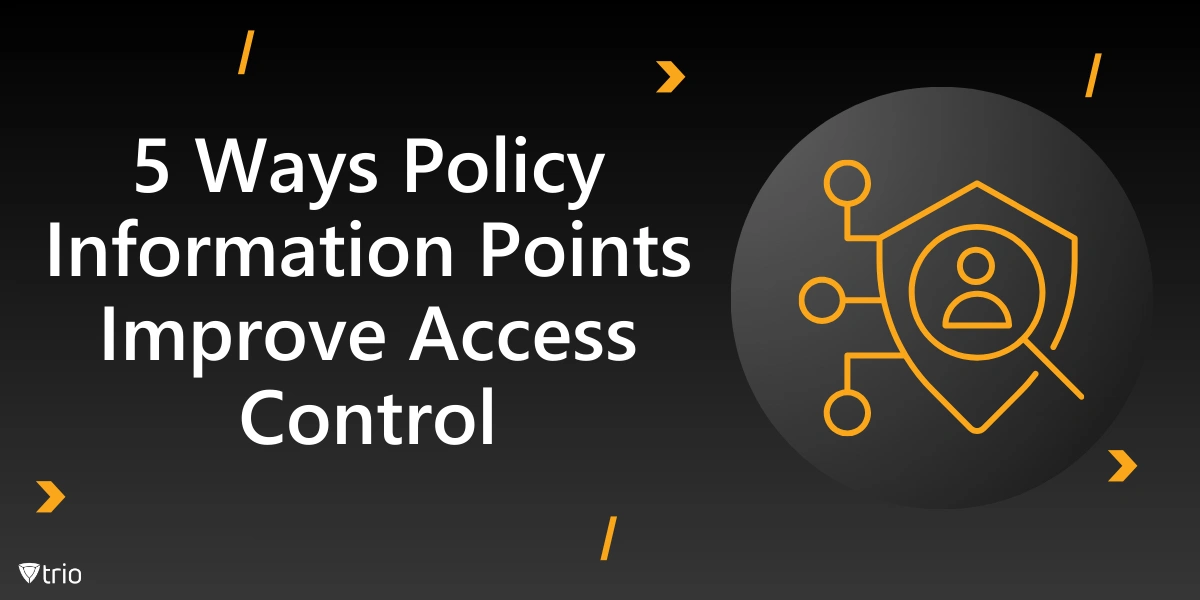To build a robust zero trust architecture, access control is pivotal as the guardian of organizational data and resources. Cyber threats evolve relentlessly, making strong access policies crucial. Effective access control prevents unauthorized access, protecting sensitive information from potential breaches that could lead to significant financial and reputational damage.
What is the meaning of the Policy Information Points in this context? Simply put, PIPs are components that provide essential data to enforce access control decisions. They feed critical attributes to policy decision points, enhancing the precision and effectiveness of access controls.
This blog post explores five significant ways that Policy Information Points enhance access control mechanisms. By exploring their impact on security, compliance, policy management, scalability, and analytics, we aim to illuminate the strategic advantages of integrating PIPs into your IT infrastructure.
What Are Policy Information Points?
Policy Information Points, commonly known as PIPs, serve as vital information providers in an access control system. They are responsible for collecting and supplying the necessary data that informs access decisions. This data can range from user attributes like roles and permissions to environmental conditions such as time and location, all of which are crucial for making accurate and context-aware determinations.
In an access control architecture, PIPs work closely with Policy Decision Points (PDPs) by feeding them with real-time information. The PDPs then evaluate this data against the defined policies to grant or deny access. Without PIPs, PDPs would lack the contextual information needed for nuanced decision-making, potentially leading to security gaps or unauthorized access.
By integrating PIPs into your access control framework, you enable a dynamic and responsive security posture. They allow for policies that can adapt based on real-time data, enhancing both security and user experience. Understanding PIPs is essential for any organization aiming to implement advanced access control mechanisms and stay ahead of evolving security threats.
With this foundational understanding in place, let’s explore how PIPs elevate security through contextual awareness and enhance decision-making processes.
1. Elevating Security With Contextual Awareness
Integrating contextual data is a game-changer in access control. PIPs gather real-time information such as user location, device status, and time of access, enriching the data pool. This contextual awareness ensures that access decisions are not based solely on static credentials but on a holistic view of the access request.
By supplying comprehensive data, PIPs enhance the decision-making capabilities of the Policy Decision Point (PDP). The synergy between the policy information point and PDP enables more accurate and tailored responses. This interaction reduces false positives and negatives, ensuring that legitimate users gain access while unauthorized attempts are thwarted.
Consider a scenario where an employee tries to access sensitive data outside business hours from an unrecognized device. A Policy Information Point example use here would be the PIP providing the PDP with the time and device details, leading to an informed decision to deny access. Such real-world applications highlight the critical role of PIPs in maintaining security.
Moreover, contextual awareness facilitated by PIPs enhances security without compromising usability. Users experience seamless access when conditions are normal, while potential threats are intercepted based on contextual cues. This balance between security and convenience is vital in modern IT environments where user experience and security must coexist.

2. Streamlining Compliance and Governance
Staying compliant with regulations is non-negotiable for organizations today. For instance, the Executive Order 14028 emphasizes the adoption of Zero Trust architectures, highlighting the need for robust access control mechanisms. PIPs play a pivotal role in aligning with these regulations by providing the necessary data to enforce strict access policies.
An effective access control system must be audit-ready at all times. PIPs contribute to this readiness by maintaining detailed logs of access requests and the data used in decision-making. This transparency simplifies the auditing process, ensuring that compliance requirements are met without excessive administrative burden.
Consistency in policy enforcement is crucial to maintain security integrity. The Policy Administration Point works in conjunction with PIPs to ensure policies are applied uniformly. This collaboration minimizes discrepancies and prevents security loopholes that could be exploited by malicious actors.
By streamlining compliance and governance processes, PIPs reduce the risk of regulatory penalties and enhance the organization’s reputation. They provide a framework that supports both security objectives and compliance mandates, creating a harmonious balance between operational efficiency and regulatory adherence.
3. Simplifying Policy Management
Managing attributes centrally simplifies policy management significantly. Understanding the roles of the policy information point vs PDP is essential here. While PIPs provide the data, PDPs make the decisions. Centralizing attribute management through PIPs ensures that all necessary information is available in one place, streamlining enforcement.
The ability to adjust policies dynamically is a critical advantage. The Policy Decision Point leverages data from PIPs to modify access controls in real-time. This dynamic adjustment allows the system to respond swiftly to changing conditions, enhancing both security and operational agility.
Simplifying policy management leads to significant efficiency gains. With PIPs providing accurate and timely data, administrative overhead is reduced. Teams can focus on strategic initiatives rather than getting bogged down in manual policy updates, resulting in better resource allocation and productivity improvements.
By simplifying policy management, organizations can adapt to new challenges more readily. The combination of centralized attribute management and dynamic policy adjustments ensures that access control remains effective without becoming a drain on resources. This adaptability is crucial in a landscape where threats and business requirements are constantly evolving.
4. Enhancing Scalability and Flexibility
In a rapidly evolving IT landscape, scalability and flexibility are paramount. An adaptable infrastructure allows organizations to respond to growth and change without compromising security. PIPs contribute to this adaptability by providing a scalable means to manage access control data across diverse systems and platforms.
PIPs facilitate seamless integration with ZTNA frameworks. Incorporating ZTNA integration ensures that access control policies are enforced consistently across all network resources, regardless of location or device. By working harmoniously with ZTNA, PIPs help establish a robust security posture that adapts to modern threats.
Investing in PIPs is a step toward future-proofing access control mechanisms. As part of comprehensive ZTNA solutions, PIPs ensure that your security infrastructure is prepared for emerging technologies and threats. They provide the flexibility to incorporate new data sources and policies as needed, keeping your organization ahead of the curve.
By enhancing scalability and flexibility, PIPs enable organizations to grow and evolve without sacrificing security. They support an infrastructure that can handle increased loads and adapt to new requirements, ensuring long-term viability of access control systems. This support is essential for businesses aiming for sustainable growth in a competitive market.
5. Facilitating Advanced Analytics and Insights
PIPs provide a wealth of data that can be analyzed for insights. This data-driven approach empowers organizations to make informed decisions about their access control policies. By understanding usage patterns and behaviors, policies can be refined to enhance both security and user experience.
Advanced analytics enabled by PIPs allow for the detection of anomalies in access requests. Unusual patterns, such as repeated failed attempts or access from unexpected locations, can be identified quickly. Early detection of such anomalies is crucial in preventing security breaches and responding proactively to potential threats.
The insights gained from PIP data contribute to the continuous improvement of access control systems. By regularly analyzing performance and outcomes, organizations can adjust policies to address new threats and optimize efficiency. This iterative process ensures that security measures remain effective over time and adapt to changing circumstances.
Facilitating advanced analytics and insights transforms access control from a static function into a dynamic, intelligence-driven process. Organizations gain a proactive stance in security management, staying ahead of potential threats and continuously enhancing their protective measures. This proactive approach is key to maintaining robust security in an ever-changing threat landscape.

Trio: Bridging MDM and Access Control
Mobile Device Management (MDM) plays a significant role in the broader context of access control. With the increasing reliance on mobile devices in the workplace, ensuring their security is paramount. MDM solutions like Trio not only manage and secure these devices but also integrate seamlessly with PIPs, extending their reach to mobile endpoints. This integration ensures that access policies are consistently enforced, regardless of the device used, enhancing overall security.
Our product, Trio, combines robust MDM features with advanced access control mechanisms, leveraging the power of PIPs. By integrating Trio into your infrastructure, you enhance security and streamline device management. We encourage you to try our free demo to experience firsthand how Trio can elevate your organization’s access control strategy.
Conclusion: The Strategic Advantage of PIPs
Throughout this article, we’ve explored how Policy Information Points significantly improve access control. From elevating security with contextual awareness to facilitating advanced analytics, PIPs transform the way organizations manage access to their resources. Their impact is both profound and multifaceted, addressing key challenges in modern IT environments.
Incorporating PIPs into your access control framework offers strategic advantages that extend beyond mere compliance. They enhance regulatory alignment, simplify policy management, and future-proof your security infrastructure against emerging threats. By leveraging PIPs, organizations position themselves to respond effectively to evolving threats and regulatory demands, gaining a competitive edge in security preparedness.
As the digital landscape continues to evolve, so must our approaches to security. Policy Information Points represent a critical component in building robust, adaptive access control systems. Embracing PIPs is not just a technical decision but a strategic move toward sustained security and operational excellence. We encourage organizations to consider integrating PIPs to bolster their access control strategies.
Get Ahead of the Curve
Every organization today needs a solution to automate time-consuming tasks and strengthen security.
Without the right tools, manual processes drain resources and leave gaps in protection. Trio MDM is designed to solve this problem, automating key tasks, boosting security, and ensuring compliance with ease.
Don't let inefficiencies hold you back. Learn how Trio MDM can revolutionize your IT operations or request a free trial today!




